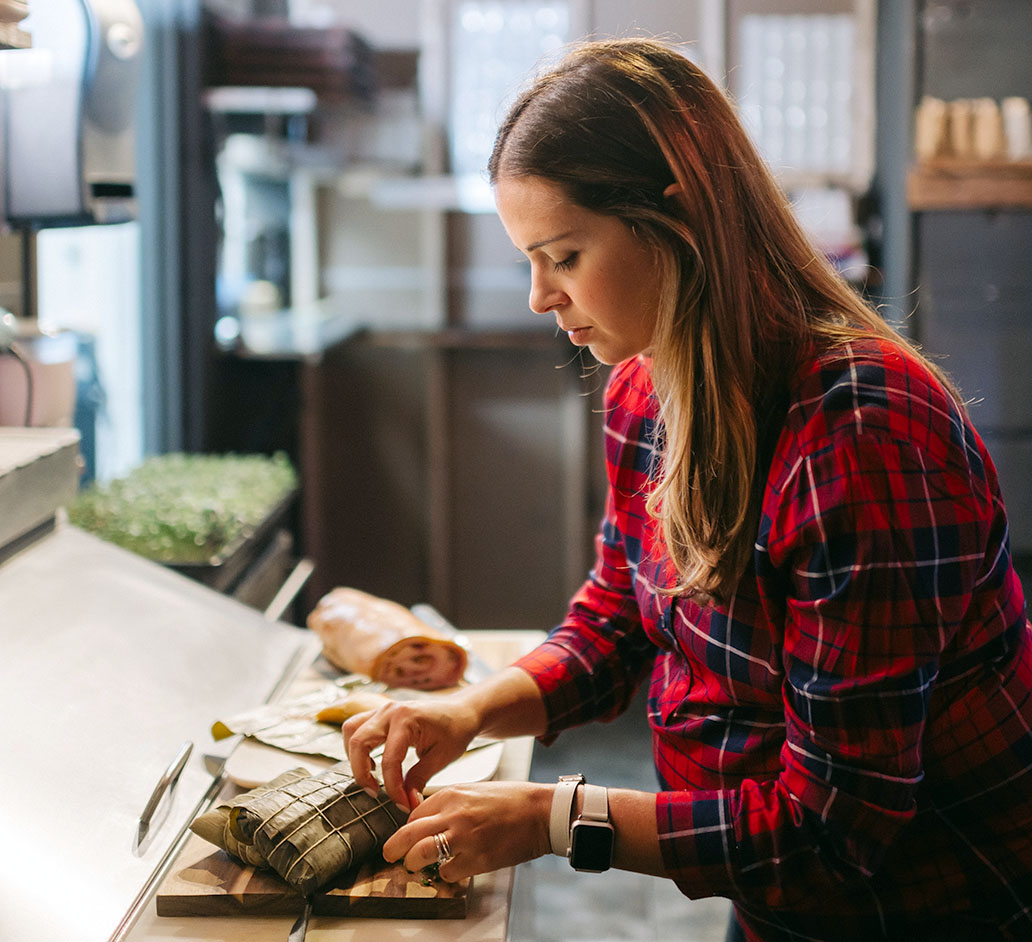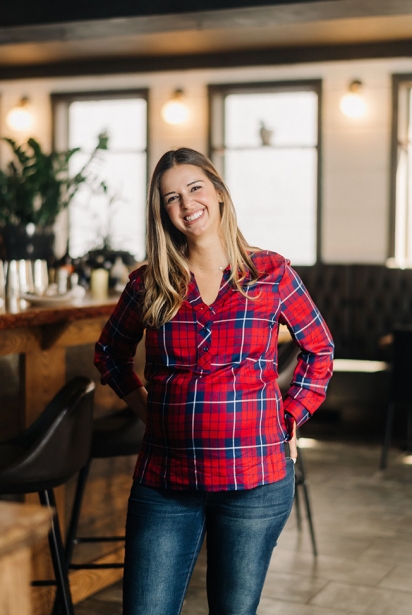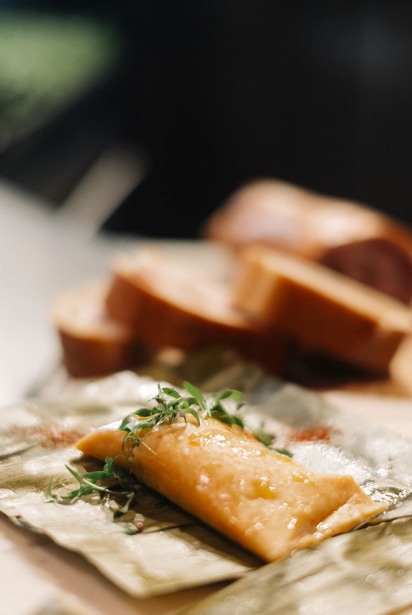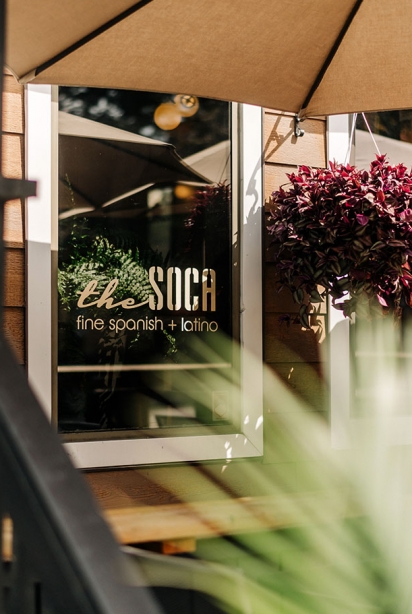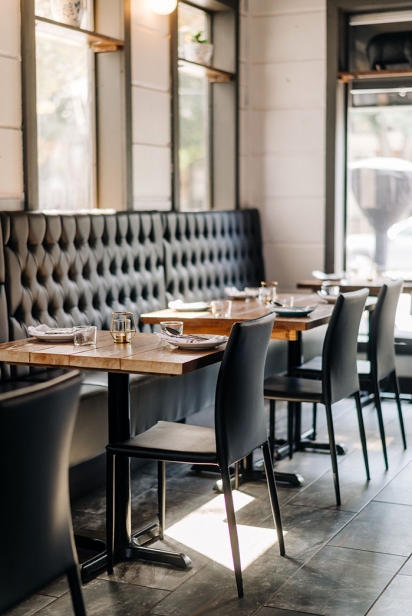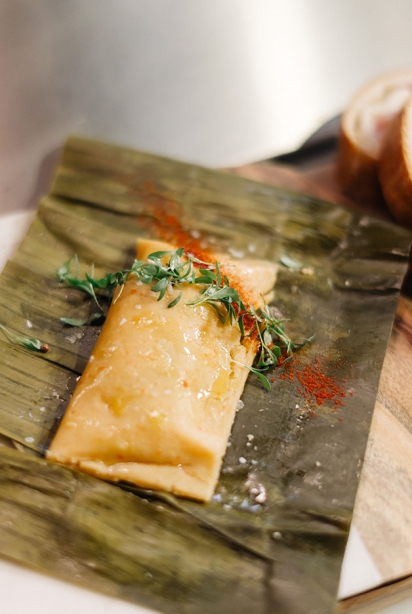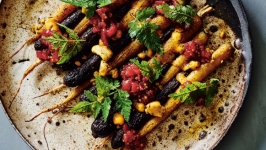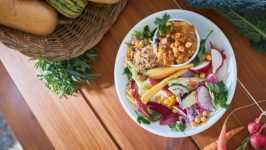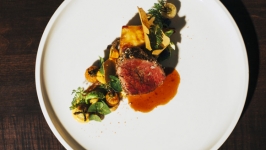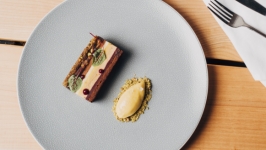A Taste of Home in Venezuela
Daniela Manrique remembers always being in the kitchen with her mom and grandmother as a child growing up in Caracas, Venezuela. Given that, it’s no surprise that when we asked her to produce a comfort-food dish that represents her on a plate, she chose to make a family favourite.
Hallacas are a uniquely Venezuelan dish. A bit similar to tamales from Mexico, they consist of cornmeal dough stuffed with a stew of several flavourful meats, some sofrito and then raisins, capers and olives to heighten the flavour, and wrapped and steamed in plantain leaves.
“It’s a big thing during the holidays,” the 32-year-old chef with the sunny disposition says. The chef and co-owner of The Soca Kitchen is sunny in spite of her state at the time of this interview — she was eight months pregnant with her first child, a baby girl who was born in October.
No doubt one day this child will join in the tradition of making hallacas, after all, it’s a family affair — you might have 10 people making them over a series of several days. On Day 1, they clean the banana leaves; on Day 2, they start making the filling.
The filling is a matter of debate, depending on what your own family served. In Manrique’s family, the filling includes three different types of meat — hen (“not chicken”), pork and beef.
“I think we use hen because it has a stronger flavour and we make the stock with hen,” she says. “Then we also use the hen meat for the stuffing. The stock is used to make the corn dough.”
Her family’s version of hallacas is on the sweeter side, because it uses papelón — the sugar derived from sugarcane. The sofrito consists of tomatoes, onions, peppers, capers and the garnishes are usually strings of peppers. The garnishes alone have their own day in the process. On the final day, the family will make the corn dough and then spread it on the cleaned banana leaves. An assembly line will form for adding the filling and garnish and then wrapping the whole thing in banana leaves. Yet more family members take on the task of tying them up.
“The wrapping is very specific,” she says. “And the filling needs to be made in advance so it can sit to marry all the flavours.”
Hallacas aren’t on the menu at Soca, but Manrique has occasionally featured them as a special during the Christmas season.
“Not everyone in the [Soca] kitchen knows about the hallacas,” she says. “So, it’s a lot of fun to make them because I get to teach them. They’re good, but they’re so much work.”
Served alongside the hallacas is pan de jamon, a traditional Venezuelan bread that Manrique’s family eats regularly during the holidays — as often as every other day, and on Christmas and New Year’s Day.
Made with plain processed ham, it also has golden raisins, olives and capers. “It’s very rustic,” Manrique says. “Nothing fancy is going into these things.”
The moist doughy bread has a sweetness, but the ham provides a savoury note to round it out.
The other side of Manrique
As Manrique puts it, her roots and her heritage define one side of her culinary approach; the other is dominated by her early experience with Mediterranean cuisine.
She lived in Venezuela until she was 10 years old, and then emigrated, with her parents, two sisters and a brother, to Montreal. After finishing high school there, she moved to Florida to pursue a bachelor’s degree in culinary management at the Fort Lauderdale Culinary Arts School.
“It was really interesting because you have the mix of the culinary arts, the basics and French cuisine and then you have the management aspect,” she says. “I knew I needed that part because I wanted to open a restaurant.”
While she was in Florida, she worked with several high-end chefs, including the person she calls her mentor: Clay Conley. Conley now owns a series of award-winning restaurants in the culinary hotspot of Palm Beach. She worked with him at Azul, the then-restaurant in the Mandarin Oriental Hotel. Later, she was on the opening team at a smaller restaurant, called Pied à Terre, in a boutique hotel called Cadet in South Beach.
“I worked a lot in Mediterranean cuisine,” she says. “Clay was my biggest mentor and my training in Mediterranean food really came from him.”
After learning her trade in Miami restaurants, she decided she was ready for a master’s degree in business to further reinforce her chances of success once she could realize her dream of opening her own restaurant. She moved back to Caracas and completed her master’s at the Instituto de Estudios Superiores de Administración.
“I also wanted to revisit where I grew up,” she says.
As it turns out, that’s where she met her husband, Gustavo Belisario, with whom she now owns Soca. The two decided to move to Canada after she completed her studies because the political situation in Venezuela, which has been bad for the past 20 years, had become intolerable.
“It’s awful. There’s nothing — no food, no toothpaste, no toilet paper,” she says. “There’s two different realities — the very poor and the very rich and the gap is really big.”
Manrique still has some family in the beleaguered country, but most have moved away. Belisario’s parents, grandparents and siblings are still there, however.
Once they were back in Canada, they started looking for a restaurant space. When the space for Soca became available, they jumped at the chance.
“I’ve always loved Ottawa — the size is perfect and my husband fell in love with Ottawa, too,” says Manrique, whose mother and also-pregnant sister now live here, too. Her father passed away in 2017, a short time after being diagnosed with leukemia.
Their first restaurant
Manrique was 27 and Belisario, an accountant by trade, but a long-time entrepreneur, was 28 when they opened Soca five years ago. Since then, the menu has evolved in response to customer preferences.
“We started with one idea, but the concept has evolved,” Manrique says. “We’ve figured ourselves out a bit. My roots from Venezuela have a lot of influence and working with Chef Clay taught me so much about Mediterranean and Spanish cooking. Now, I like to fuse them together here.”
When they launched, even ceviche was a tad exotic for their neighbourhood restaurant, but today it’s a hit. Other items that initially freaked out customers include pig’s ears and whole fried fish — apparently being able to see the head was a deterrent to eating it. Customers even viewed arepas — Venezuelan corn patties — with skepticism.
“Since we opened, I’ve been learning about the seasons and what’s available here,” Manrique says. “It took me a while to learn about the farmers and embrace all of that. My biggest struggle was getting used to the seasons because in Florida, there really aren’t seasons.”
These days, as Hintonburg tastes become more adventuresome, she’s been bringing some of those original dishes back, sometimes with a Canadian twist.
“Right now, we have tacos made with cactus,” she says. “By putting it in tacos, it’s a little more relatable.”
In spite of those early customer apprehensions, business has been good. And an upstairs room they make available for private events has been a boon.
“We work with a lot of pharmaceutical reps and doctors,” she says. “They love it here. We also have a lot of repeat customers. Many of them live in the neighbourhood.”
Inspirations from everywhere
Asked where she finds inspiration, Manrique doesn’t hesitate. She finds it in new ingredients and techniques.
“I’m constantly playing with things,” she says. “I’m not doing the same thing everyone else is doing.”
She usually finds those new ingredients while travelling. Recently, she and Belisario have been to Mexico City, which she says is a great food city. They’ve also been to Barcelona and Madrid and, on another trip, to Italy.
She remembers driving through very small towns on the way from Rome to Florence and she fondly recalls one memorable meal in a tiny restaurant in which the server was also the cook and owner.
“We went into her restaurant and she sat us down and asked us what we wanted to eat, then she fed us,” she recalls. “She kept standing next to our table, demanding to know how everything was. It was the most authentic and amazing food we’ve ever had.”
Now, Manrique has set her travel sights on Asia.
“I like the fusion. I’d like to learn about that culture and learn about the ingredients,” she says. “Or, it might not be fusion, it might be that I see a new technique for an ingredient that I use every day.”
And what inspired the name of the restaurant? “Soca is the second growth of the sugarcane,” Belisario says. “You plant it and then it will regrow a few times. The first time, it’s called plantilla — they cut it and replant so they can grow even more. And the second one is when they harvest.”
When he lived in Venezuela, Belisario had plantations. Today, his family looks after them for him. He says when they opened Soca, they used a lot of sugarcane. Today, they use it in a yucca fry dish that has a reduction of sugarcane, chorizo and parmesan on top. “It’s a version of poutine,” he says with a laugh. “It’s popular.”
For Manrique, who eats “everything and anything,” pregnancy was cramping her eating style, with limitations on raw fish and unpasteurized cheeses and wine. It also scuttled plans last winter to ski during a family vacation to St. Sauveur. Her doctor told her she couldn’t ski so she hung out indoors. Once the baby was born, she planned to take some time off, but not much, and even at eight months pregnant, she was still running many of the administrative aspects of the business while her husband manned front of house. He also makes the signature cocktails, such as creative pisco sours — with three pickled grapes on top — and mojitos.
When she thinks about food, Manrique says her dishes must always have an earthiness, something fresh, something acidic, and something sweet and salty.
One of the most popular dishes in the restaurant is the $89 seafood tower that includes oysters, mussel escabeche, cocktail shrimp and steamed lobster. Other hits are the clam ceviche and the calamari. In addition, they have a good vegan following as several of the dishes — including a signature cauliflower steak — are vegan.
And, come Christmas, you can bet the hallacas will return, just like Santa Claus and bad Christmas music in shopping malls always do.
The Soca Kitchen
93 Holland Ave., Ottawa, Ont.
thesocakitchen.com | 613.695.9190 | @thesocakitchen


